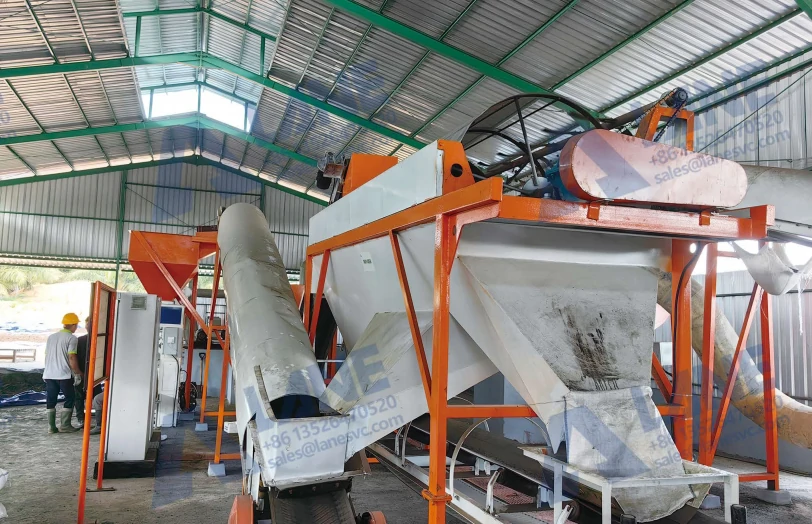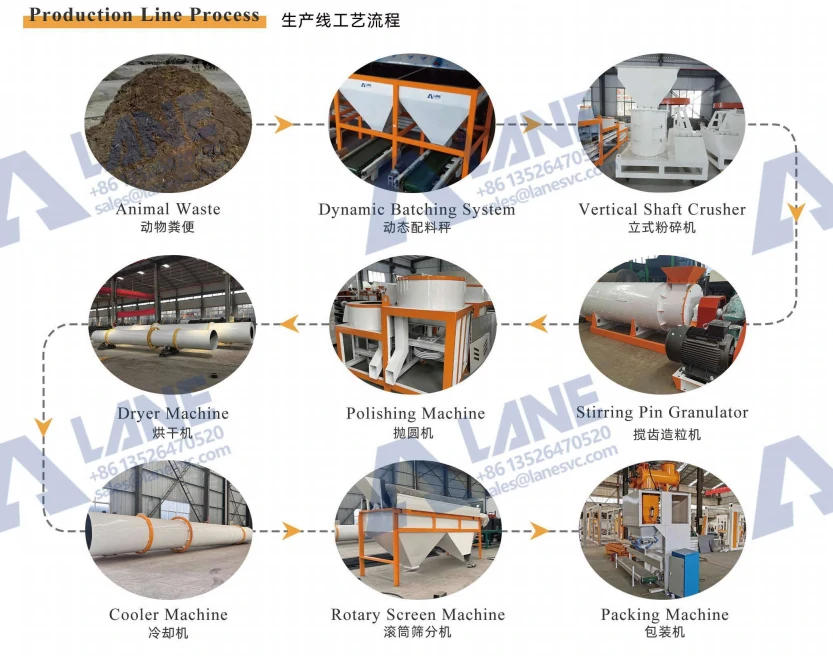Across the world, livestock farming is expanding rapidly—but so are the challenges of managing the vast amount of animal manure it produces. What was once considered waste is now recognized as a valuable resource. With the right technology, livestock manure can be transformed into nutrient-rich organic fertilizer that supports sustainable agriculture and environmental protection.
This transformation is made possible by the livestock manure organic fertilizer production line, a modern, efficient, and eco-friendly system designed to convert raw manure into high-quality organic fertilizer. At LANE, we specialize in engineering complete fertilizer production solutions that help farms and agribusinesses close the nutrient loop—turning waste into opportunity.

The Global Challenge of Livestock Waste
Every year, billions of tons of livestock manure are generated worldwide. Cattle, poultry, and pig farms are under increasing pressure to manage this waste safely. Improper disposal not only contaminates soil and groundwater but also emits greenhouse gases such as methane and nitrous oxide.
However, within this challenge lies a tremendous opportunity. Livestock manure contains essential nutrients like nitrogen (N), phosphorus (P), and potassium (K)—the building blocks of plant growth. Through scientific processing in a livestock manure organic fertilizer production line, these nutrients can be stabilized, sanitized, and transformed into a powerful soil amendment.
Why Choose an Livestock Manure Organic Fertilizer Production Line?
Unlike traditional composting or manual drying, a fully equipped livestock manure organic fertilizer production line allows for large-scale, continuous, and hygienic production of organic fertilizer. The advantages include:
Efficient Waste Recycling
The system converts raw manure into valuable fertilizer, reducing pollution and odor emissions.
High Nutrient Preservation
Controlled fermentation ensures that key nutrients remain intact rather than lost through volatilization.
Pathogen Elimination
High-temperature aerobic fermentation destroys harmful bacteria, parasites, and weed seeds.
Economic Benefit
The end product—organic fertilizer—can be sold or reused on farms, creating a sustainable revenue stream.
Regulatory Compliance
Many regions now require livestock operations to implement waste treatment systems; a production line helps meet environmental standards.
From Manure to Market: The Production Process Explained
Transforming livestock manure into market-ready organic fertilizer is a carefully orchestrated process that combines biology, engineering, and environmental science. Within a modern livestock manure organic fertilizer production line, every stage serves a distinct function—ensuring that the final product is rich in nutrients, free from pathogens, and stable for storage and sale.
Let’s break down the process step by step.
1.Raw Material Collection and Preparation
The journey begins with the collection of livestock manure from cattle, poultry, or pig farms. Fresh manure is rich in organic matter but also high in moisture and potential contaminants. To make it suitable for processing, it first enters a solid–liquid separation system.
This equipment removes excess water, reducing the moisture content from around 80% to 60%—the optimal range for fermentation.
The separated liquid can be reused in irrigation systems or biogas production, while the solid portion becomes the foundation material for the organic fertilizer. This crucial pre-treatment step sets the stage for efficient downstream processing within the livestock manure organic fertilizer production line.
2.Controlled Fermentation and Composting
Fermentation is the heart of the production process. Here, raw manure is biologically transformed into stable compost through aerobic microbial activity. Inside a fermentation reactor or a windrow composting system, oxygen and temperature are closely monitored to create an ideal environment for beneficial microorganisms.
LANE’s advanced fermentation systems feature automatic temperature regulation, aeration control, and mechanical turning, ensuring that the composting process is uniform and fast. Within 7–15 days, high temperatures above 60°C eliminate harmful bacteria, parasites, and weed seeds.
The result is a sanitized, mature compost with a pleasant earthy smell—free from ammonia odor and pathogens.
This stage is critical to the success of any livestock manure organic fertilizer production line, as it converts unstable waste into a biologically safe, nutrient-rich material suitable for granulation.
3.Crushing and Homogenization
After fermentation, the composted material often contains clumps and uneven textures. The next step is crushing and homogenization, where a specialized grinder breaks the material into fine, consistent particles.
A uniform particle size ensures better mixing with other ingredients and smoother granulation later on. Depending on the fertilizer formula, additives such as humic acid, straw powder, or microbial inoculants may be introduced at this stage to enhance soil-improving properties.
This blending process allows producers to tailor fertilizer compositions to local agricultural needs—whether for rice fields, vegetable farms, or large plantations.
4.Granulation – Shaping the Fertilizer
Granulation is where compost officially becomes a marketable product. In this phase, the fine compost powder is transformed into granules or pellets using granulating equipment such as a disc granulator, rotary drum granulator, or stirring tooth granulator.
Each type of granulator serves a specific purpose:
Disc granulator – for small to medium capacity lines with flexible particle control.
Stirring pin granulator – suitable for sticky or fibrous organic materials.
Inside the granulator, controlled moisture and rotation force the particles to bind naturally, forming smooth, round granules.
LANE engineers customize granulation parameters such as speed, inclination, and spray volume to achieve high efficiency and a uniform, strong granule structure.
5.Drying and Cooling
Freshly granulated fertilizer contains residual moisture, which must be removed to ensure stability and long shelf life. The granules enter a rotary drying drum, where warm air gently evaporates the remaining water without destroying beneficial microorganisms.
After drying, the granules pass into a cooling drum to reduce temperature and prevent caking during storage. This step also helps maintain granule hardness and prevents nutrient loss.
The combination of drying and cooling ensures that every batch produced by the livestock manure organic fertilizer production line meets strict quality and storage standards.
6.Screening and Quality Control
To achieve consistent product quality, the dried and cooled granules are screened through a rotary screen machine. Oversized particles are crushed and recycled, while undersized ones are returned to the granulator for reprocessing.
Only uniform, perfectly sized granules move forward to the packaging stage.
LANE integrates automated screening and feedback systems that maintain efficiency and reduce material loss—ensuring a clean, professional-grade product ready for commercial sale.

7.Packaging and Storage
The final stage is packaging, where the finished organic fertilizer is weighed, filled, and sealed using an automatic packaging machine. The system can handle various packaging formats—typically 25 kg or 50 kg bags—depending on local market requirements.
Proper packaging preserves product quality and protects the fertilizer from moisture and contamination. Once packed, the fertilizer is stored in a clean, dry warehouse, awaiting transport to distributors, cooperatives, or farms.
At this point, the once-problematic livestock waste has completed its transformation into a valuable agricultural commodity, closing the loop between livestock farming and crop cultivation.

LANE’s Technological Edge
At LANE, we combine advanced engineering with practical experience to deliver the most reliable livestock manure organic fertilizer production lines. Our advantages include:
Customized Plant Design – Tailored to local manure sources (cow, pig, chicken, or mixed).
Automated Control Systems – For precise temperature, moisture, and aeration management.
Durable, Corrosion-Resistant Materials – Ensuring longevity under harsh working conditions.
Energy-Efficient Layouts – Optimized to reduce power consumption and operation costs.
End-to-End Support – From factory layout planning to on-site installation and operator training.
LANE has successfully implemented projects across Asia, the Middle East, and Africa, supporting both commercial farms and government-backed waste recycling programs.
The livestock manure organic fertilizer production line is far more than an industrial setup—it is a sustainable bridge between animal husbandry and modern agriculture. By converting waste into wealth, this technology provides a practical answer to two of the world’s most pressing challenges: environmental pollution and soil degradation.
With proven global experience and technical expertise, LANE continues to deliver innovative fertilizer production solutions that empower clients to build greener, more resilient agricultural systems. From waste management to soil regeneration, LANE’s technology ensures that every farm can turn challenges into opportunities—sustainably, efficiently, and profitably.
For more details, please feel free to contact us.
Henan Lane Heavy Industry Machinery Technology Co., Ltd.
Email: sales@lanesvc.com
Contact number: +86 13526470520
Whatsapp: +86 13526470520